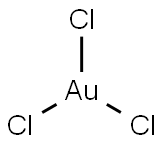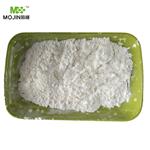Chemical Properties
orange-red to dark red crystals
Physical properties
Red monoclinic crystals; deliquesces; density 4.7 g/cm
3; sublimes at 180°C (760 torr); highly soluble in water; soluble in alcohol and ether; slightly soluble in liquid ammonia.
Uses
It is important to note that the Cl2 used here must be
hot chlorine gas.
Uses
Photography, gold plating, special inks,
medicine, ceramics (enamels, gilding, and painting
porcelain), glass (gilding, ruby glass), manufacture
of finely divided gold and purple of Cassius.
Uses
Gold(III) chloride is used in colloidal gold solutions, in photography and as a print toning agent(gold toning), starting solution to form other gold compounds and a precursor for preparation of ultra pure gold metal. It is used in electroplating and electroless plating as an anode in an electric cell. Gold(III) chloride acts as a gold catalyst and cell body stains for bright field and dark field microscopy.
Definition
A compound prepared by
dissolving gold in aqua regia. The bright
yellow crystals (chloroauric acid) produced
on evaporation are heated to form dark red
crystals of gold(III) chloride. The chloride
decomposes easily (at 175°C) to give
gold(I) chloride and chlorine; at higher
temperatures it decomposes to give gold
and chlorine. Gold(III) chloride is used in
photography. It exists as a dimer, Au
2Cl
6.
Preparation
Gold(III) chloride may be produced by the combination of metallic gold with chlorine gas at elevated temperatures:
2Au + 3Cl2 → 2AuCl3
It may be prepared in the laboratory by the reaction of iodine monochloride with metallic gold:
2Au + 6ICl → 2AuCl3 + 3I2
The compound should be stored tightly closed and protected from light.
Reactions
When heated at 254ºC, gold(III) chloride decomposes to gold(I) chloride and chlorine.
Passing hydrogen sulfide into an ether solution of the compound yields gold(III) sulfide, Au2S3.
A similar reaction occurs when alcoholic solutions of gold(III) chloride and hydrogen selenide are mixed, producing gold(III) selenide, Au2Se3, a black amorphous solid.
Gold(III) chloride may be reduced readily to metallic gold by common reducing agents. Thus, reduction with stannous chloride in dilute aqueous medium yields colloidal gold in which the atom carries a negative charge. “Cassius purple” is produced from the oxidation of tin to form H2Sn(OH)6, which protects colloidal gold from coagulation, imparting ruby red color to the solution.
Gold(III) chloride reacts with ammonia forming a gold(III)-nitrogen derivative, an explosive product, known as, “fulminate of gold”. Reaction with Grignard reagent, RMgX in ether yields dialkyl gold(III) chloride, R2AuCl3, which may be converted readily to other dialkyl gold(III) complexes by replacement of the chloride anion by a donor ligand.
General Description
The structure of gold chloride is monoclinic in nature. It sublimes at elevated temperatures.
reaction suitability
reagent type: catalyst
core: gold
Safety Profile
Experimental
reproductive effects. Human mutation data
reported. Reaction with ammonia or
ammonium salts yields fulminating gold, a
heat-, friction-, and impact-sensitive
explosive similar to mercury and silver
fulminates. See also GOLD COMPOUNDS
and CHLORIDES. When heated to
decomposition it emits toxic fumes of Cl-.




